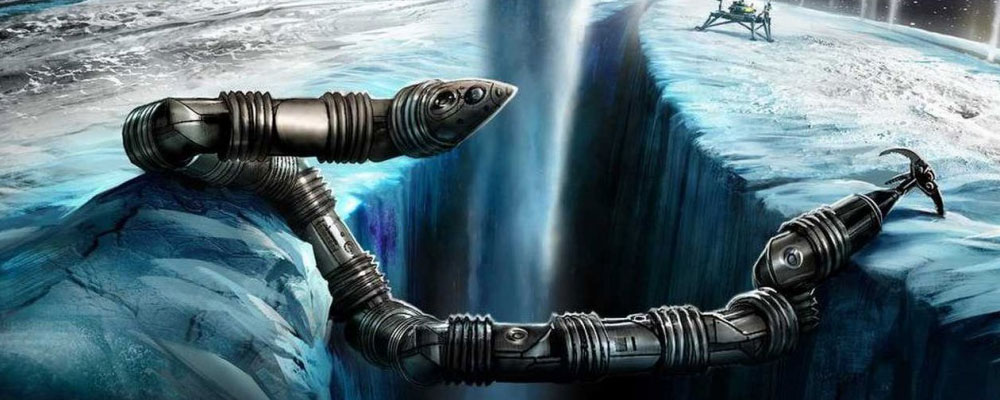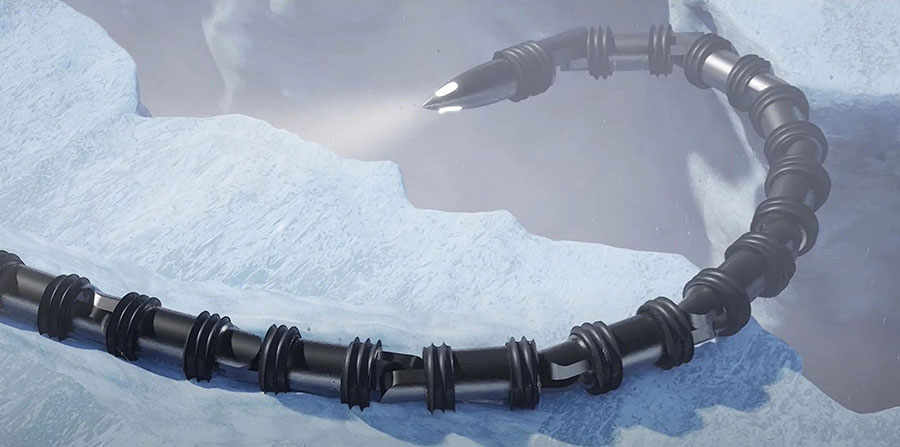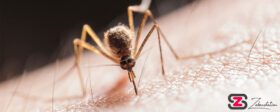
نحوه یادگیری زبان انگلیسی با این پادکست
در ابتدا باید خلاصه فارسی این پادکست انگلیسی با متن را مطالعه کنید تا یک دید کلی از موضوعی که در پادکست صحبت میشود به دست بیاورید. سپس صوت را پخش کنید و همراه با متن پیش بروید. یک بار کامل گوش کنید و سعی کنید تا حد امکان متوجه موضوعات بشوید. در پایان لغات جدیی که بلد نبودید را پیدا کنید و یادبگیرید. حالا دوباره پادکست را با متن گوش کنید و ببینید. شیوه یادگیری را به ترتیب برای شما در زیر نوشتهایم حتما طبق آن پیش بروید.
- مطالعه خلاصه فارسی پادکست
- گوش دادن به پادکست همراه با مشاهده متن انگلیسی
- پیدا کردن و یادگیری لغات جدید
- گوش دادن مجدد به پادکست همراه با متن انگلیسی
- گوش دادن به پادکست بدون متن
- پاسخ به آزمون مربوط به پادکست
خلاصهای از پادکست انگلیسی جستجوی حیات در منظومه شمسی
NASA در حال تست روباتی به نام EELS است که شبیه یک مار است و برای جستجوی نشانههای زندگی در مکانهای با دسترسی سخت طراحی شده است. این ربات قادر است در زمین، آب، و شرایط سرد حرکت کند. تیم مهندسی در JPL NASA به توسعه این روبات مشغول هستند. EELS مستقل و بدون کنترل انسان در موقعیتهای واقعی خودش عمل میکند. هدف اصلی طراحی این ربات، جستجوی نشانههای زندگی در اقیانوس، ماه و سیارات است. این ربات مارپیچ شکل با پیچهایی که قادر به حرکت در جهات مختلف هستند ساخته شده است. در آزمایشها، از پیچهای ساخته شده از پلاستیک سهبعدی و فلزی استفاده شده است. این ربات توانایی تشخیص محیط خود را دارد و بدون کمک انسان مشکلات خود را رفع میکند. در نهایت، EELS در نسخه نهایی خود شامل ۴۸ واکنشگر (سنسور) است که به ربات امکان تغییر شکل و عملکرد پیچیده را میدهد. تیم در حال حاضر بیشترین تلاش را برای توسعه حرکات و تواناییهای خودکار ربات انجام میدهند.
The American space agency NASA is testing a snake-like explorer designed to search for signs of life in hard-to-reach places.
The robot is known as the Exobiology Extant Life Surveyor, or EELS. NASA said the robot is equipped to move in ways that traditional explorer vehicles, called rovers, cannot. Engineers at NASA’s Jet Propulsion Laboratory (JPL) in California are leading the development of the explorer.
EELS is built to explore on its own, without real-time human control. It is being designed to operate on land, in water and in harsh freezing conditions, NASA engineers said. The current model is now being tested in different environments. Future development will be based on how the current model performs.
The team said the idea for the snake-like robot came from NASA’s desire to search for signs of life in an ocean on Saturn’s moon Enceladus. That ocean is thought to exist beneath the moon’s icy surface.
The current version of EELS weighs about 100 kilograms and stretches four meters long. It is made up of 10 identical pieces, called screws, which can turn in different directions. The screws use an auger effect to move along surfaces. Parts of the robot can rise up or down to reach different places for capturing data.
The testing has involved screws made of 3D printed plastic as well as metal. The plastic screws have performed better on general surfaces, while the metal ones have been good in ice, the team said. Engineers have already tested EELS in several environments, including sand, snow and ice.
Hiro Ono is the lead investigator for JPL on the EELS project. He said in a statement the robot’s development requires very different methods from those used for traditional spacecraft and explorers.
Ono noted that a lot of information exists about how to design a four-wheeled vehicle. “There is no textbook about how to design an autonomous snake robot to boldly go where no robot has gone before,” he said. “We have to write our own. That’s what we’re doing now.”
The developers said EELS is designed to operate on its own because of the communications delays that exist between Earth and deep space. So, the team is seeking to make the robot’s technology able to sense its environment, estimate risk and travel and collect data with science instruments that are still being developed.
The team noted that it will also be important for the explorer to be able to recover on its own without human assistance when it experiences difficulties.
The project’s autonomy lead researcher, Rohan Thakker, compared the EELS technology to that used in self-driving vehicles, but in a much different environment. “Imagine a car driving autonomously, but there are no stop signs, no traffic signals, not even any roads. The robot has to figure out what the road is and try to follow it,” Thakker said. “Then it needs to go down a 100-foot drop and not fall.”
The team said, in its final form, the robot will contain 48 actuators. Actuators are devices that act as small motors for the EELS robot. The actuators are designed to give the explorer the ability to change into different forms, while operating complex machines and software systems. Thakker compared the actuators to steering wheels on a car.
JPL’s Matthew Robinson is the project manager for EELS. He said the team is currently putting the most effort into developing the robot’s movements and autonomous abilities. He said, later, they will consider what science instruments can be put on the EELS.
“Scientists tell us where they want to go, what they’re most excited about, and we’ll provide a robot that will get them there…we just have to build it,” Robinson said.
I’m Bryan Lynn.

Words in This Podcast
لغات مهم این پادکست
identical –adj. exactly the same
auger – n. a tool made of a twisted rod of metal attached to a handle, used for making large holes in wood or the ground
autonomous – adj. independent and having the ability to operate on its own
bold – adj. not frightened of danger
figure out – v. (phrasal) to find a way of doing something or solving a problem
foot –n. an English measure of distance equal to about .3 meters
motor –n. a machine that produces motion or power
steering wheel – n. a wheel in a vehicle that the driver turns in order to make the vehicle go in a particular direction
Quiz – NASA Tests Snake-Like Robot to Search for Life in the Solar System
آزمون پادکست انگلیسی جستجوی حیات در منظومه شمسی
Developers of the EELS robot say it is designed to operate on land, in water and in harsh freezing conditions.
Matthew Robinson said researchers are putting most of their development efforts into the robot’s movements and autonomous abilities.
The EELS robot will aim to explore an ocean thought to exist beneath the surface of Enceladus.
The developers said EELS is designed to operate on its own because of communication delays that exist between Earth and deep space.










دیدگاهها (0)